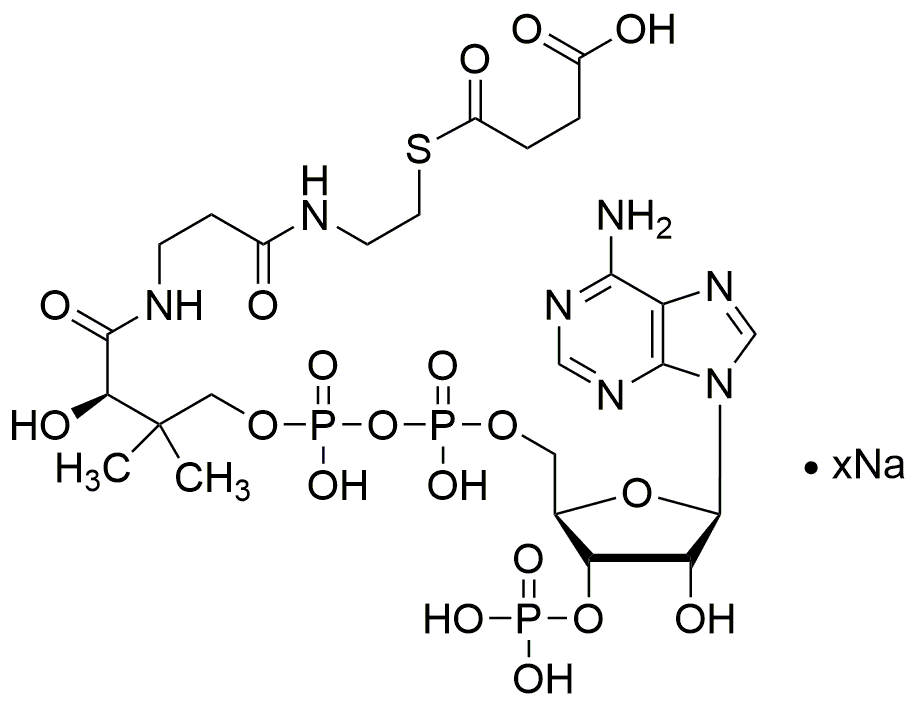Succinyl coenzyme A sodium salt is widely utilized in research focused on:
- Metabolic Studies: This compound plays a crucial role in the citric acid cycle, making it essential for researchers studying cellular respiration and energy production in various organisms.
- Biochemical Assays: It is commonly used in enzyme assays to evaluate the activity of enzymes involved in metabolic pathways, providing insights into enzyme kinetics and regulation.
- Pharmaceutical Development: The compound is explored in drug formulation, particularly in the development of therapies targeting metabolic disorders, enhancing drug efficacy and bioavailability.
- Food Industry Applications: Its role as a food additive helps in flavor enhancement and preservation, making it valuable for food scientists working on product development and safety.
- Biotechnology: Used in the production of biofuels and bioproducts, it supports researchers in optimizing fermentation processes and improving yield in microbial cultures.
Informations générales
Propriétés
Sécurité et réglementation
Applications
Succinyl coenzyme A sodium salt is widely utilized in research focused on:
- Metabolic Studies: This compound plays a crucial role in the citric acid cycle, making it essential for researchers studying cellular respiration and energy production in various organisms.
- Biochemical Assays: It is commonly used in enzyme assays to evaluate the activity of enzymes involved in metabolic pathways, providing insights into enzyme kinetics and regulation.
- Pharmaceutical Development: The compound is explored in drug formulation, particularly in the development of therapies targeting metabolic disorders, enhancing drug efficacy and bioavailability.
- Food Industry Applications: Its role as a food additive helps in flavor enhancement and preservation, making it valuable for food scientists working on product development and safety.
- Biotechnology: Used in the production of biofuels and bioproducts, it supports researchers in optimizing fermentation processes and improving yield in microbial cultures.
Documents
Fiches de données de sécurité (FDS)
La FDS fournit des informations de sécurité complètes sur la manipulation, le stockage et l’élimination du produit.
Spécifications du produit (PS)
Le PS fournit une description complète des propriétés du produit, notamment sa composition chimique, son état physique, sa pureté et les exigences de stockage. Il détaille également les plages de qualité acceptables et les applications prévues du produit.
Certificats d'analyse (COA)
Recherchez des certificats d'analyse (COA) en saisissant le numéro de lot du produit. Les numéros de lot et de lot se trouvent sur l'étiquette d'un produit, après les mots « Lot » ou « Lot de fabrication ».
Numéro de catalogue
Numéro de lot/série
Certificats d'origine (COO)
Ce certificat d'exploitation confirme le pays dans lequel le produit a été fabriqué, et détaille également les matériaux et composants utilisés et s'il est issu de sources naturelles, synthétiques ou autres sources spécifiques. Ce certificat peut être requis pour les douanes, le commerce et la conformité réglementaire.
Numéro de catalogue
Numéro de lot/série
Fiches de données de sécurité (FDS)
La FDS fournit des informations de sécurité complètes sur la manipulation, le stockage et l’élimination du produit.
DownloadSpécifications du produit (PS)
Le PS fournit une description complète des propriétés du produit, notamment sa composition chimique, son état physique, sa pureté et les exigences de stockage. Il détaille également les plages de qualité acceptables et les applications prévues du produit.
DownloadCertificats d'analyse (COA)
Recherchez des certificats d'analyse (COA) en saisissant le numéro de lot du produit. Les numéros de lot et de lot se trouvent sur l'étiquette d'un produit, après les mots « Lot » ou « Lot de fabrication ».
Numéro de catalogue
Numéro de lot/série
Certificats d'origine (COO)
Ce certificat d'exploitation confirme le pays dans lequel le produit a été fabriqué, et détaille également les matériaux et composants utilisés et s'il est issu de sources naturelles, synthétiques ou autres sources spécifiques. Ce certificat peut être requis pour les douanes, le commerce et la conformité réglementaire.


